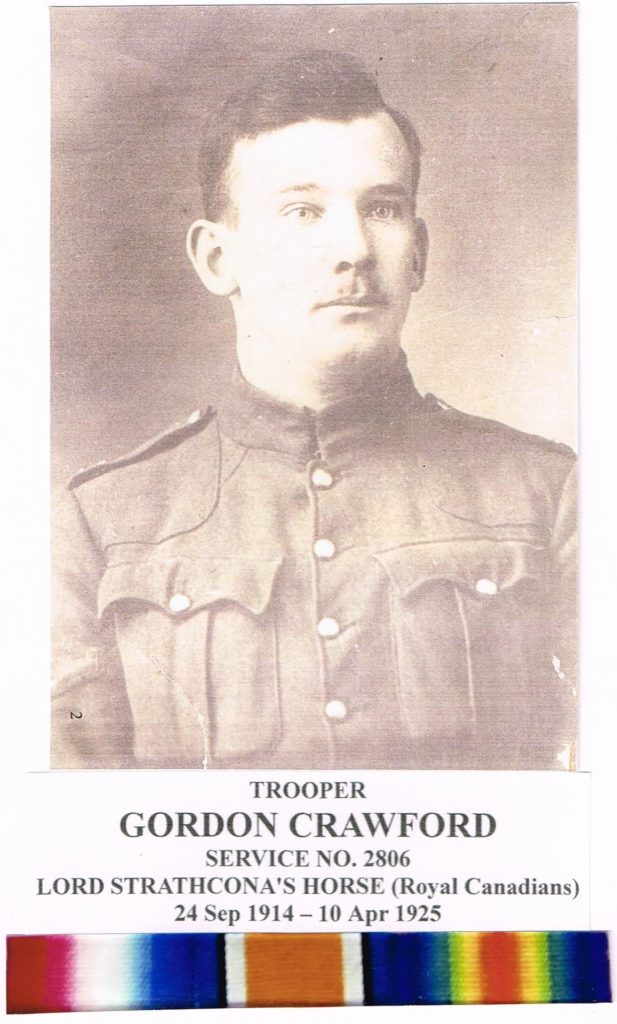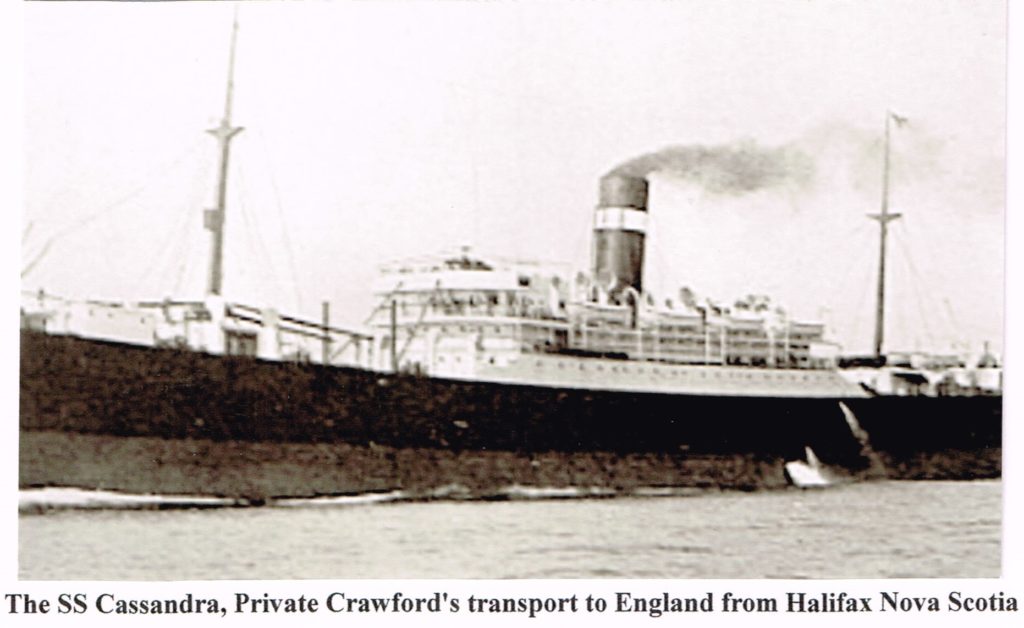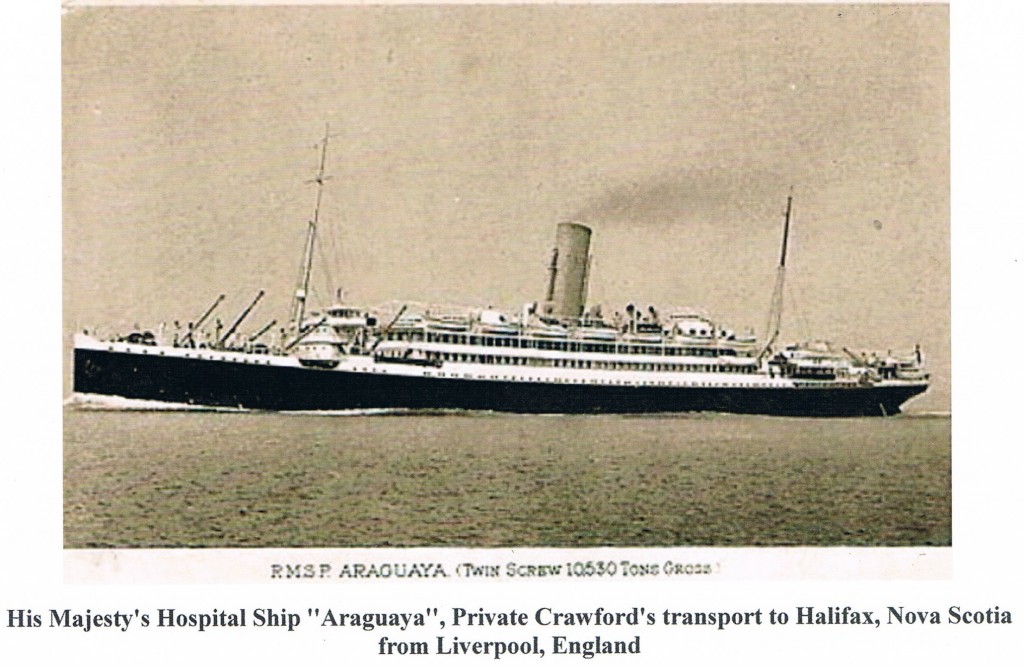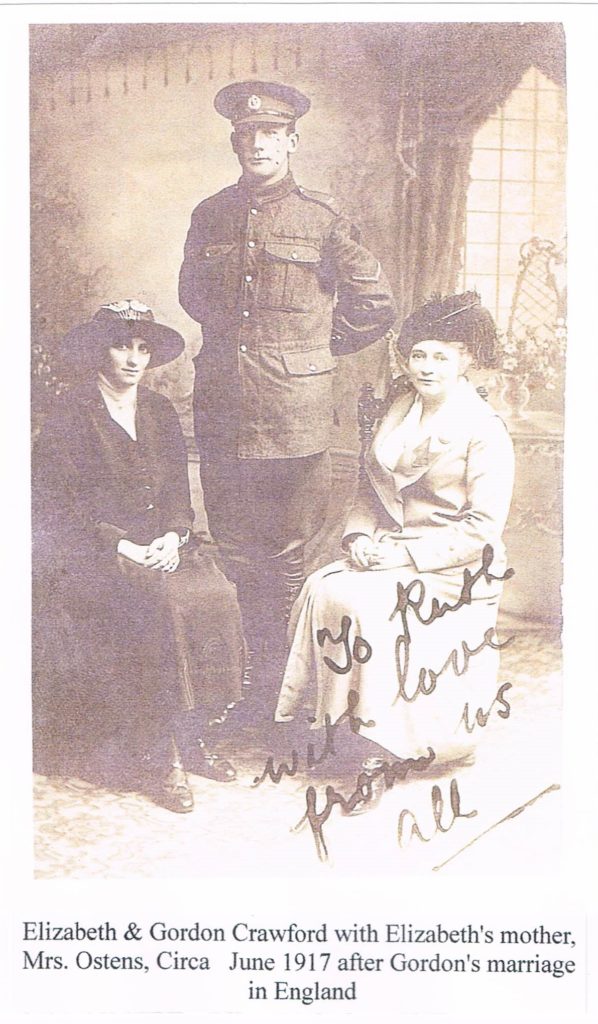Trooper Gordon Crawford – 2806– ACTIVE SERVICE (World War I)
On September 24, 1914, Gordon Crawford completed the Attestation Paper for the Canadian Army (Expeditionary Force) at Valcartier, Québec. He was 21 years, and 4 months old, when, as a single man he enlisted for the duration of the War. Gordon was born in Lakefield, Ontario, and gave his birth-date as May 10, 1893*. On his Attestation Paper, Gordon indicated ”he did not presently belong to an Active Militia, and that he had never served in any Military Force”. However, an entry in his documents has him as a Private with the 103rd Regiment Calgary Rifles, 10th Battalion from September 1 to 21, 1914 and selected to be sent Overseas on October 3, 1914, somewhat confusing. There is nothing on his File to indicate where he was educated or to what level. As far as his Trade or Calling is concerned, he lists Tinsmith. Gordon was 5′ 11″ tall, with a 39” chest (expanded); his weight is not listed. Gordon had a fair complexion, with blue eyes, and dark brown hair. His Medical Records indicate that he had a birthmark on left thumb, and a tattoo mark on right forearm – “heart pierced with sword”. Overall, he was deemed fit for Overseas duty with the Canadian Expeditionary Force. His next-of-kin was listed as his father Richard Crawford of Lakefield. Gordon signed the Oath and Certificate of Attestation September 24, 1914, in Valcartier, Québec. The Certificate of Magistrate was signed by the Justice on September 24, 1914. Gordon Crawford was taken-on-strength, as a Private (Pte), with the Lord Strathcona’s Horse (Royal Canadians) (LSH [RC]), an Armoured Regiment based in Lethbridge Alberta. Pte Crawford was assigned Regimental Number 2806. *Actual date is May 20, 1894.
Valcartier, Québec was constructed as a Military Base, in August 1914, as part of the mobilization of the Canadian Expeditionary Force, at the outset of World War I. The Base was located approximately 16 miles north of Québec City. The facilities and training were pretty rudimentary. Training consisted of marching, rifle and bayonet drills. The officers were trained in the correct use of a pistol and practiced swordsmanship. The main goal of the Base was to form the men in Units, and ship them off to England, as quickly as possible. Pte Crawford, and his Unit, sailed from Québec City, Québec for England on October 3, 1914, aboard the SS Cassandra having completed just 8 days of training. They would have disembarked the United Kingdom (UK) about October 13, 1914.
After about 3 months and 13 days of Basic and some Advanced Training, the first entry, in Pte Crawford’s File indicates that on January 26, 1915, he was Absent Without Leave at Pewsey, a large Village in Wiltshire County, England. On February 1, 1915, this Order was canceled; a note indicates that Pte Crawford returned from sick leave March 13, 1915. Pte Crawford embarked for France on May 4, 1915 and disembarked May 5, 1915. The LSH (RC) fought as Infantry in the trenches through 1915, from May 6 to 25, 1915 they were in action at the Second Battle of Ypres. August 17, 1915, Crawford was admitted to No 2 Canadian Field Ambulance (CFA) with a gunshot wound to the right hand. The Medical Record indicates that the injury occurred as a result of a ”cartridge explosion”. Based on this explanation, this injury could have been caused by a malfunction of his Ross rifle.
A Field Ambulance was a mobile Medical Unit operating quite close to the Front-Line and received wounded and sick men. The job of the Field Ambulance personnel was to provide rudimentary treatment to men who could be quickly returned to their Unit, or pass them on for further treatment at a Casualty Clearing Centre.
On August 27, 1915, Pte Crawford was admitted to the No 3 Canadian General Hospital (CGH) at Le Treport, France from No 2 CFA. On the same day he was transferred to No 22 General Hospital at Camiers, France from the No 3 CGH. On August 28, 1915, Pte Crawford is taken-on-strength to No 22 General Hospital at Camiers from No 3 CGH. Then, September 3, 1915, Pte Crawford was discharged to Base Details from No 22 General Hospital. September 10, 1915, he was discharged to No 6 Station Hospital at Le Havre, France, and admitted to No 2 General Hospital at Le Havre, France. September 17, 1915, he was discharged from No 2 General Hospital to a Reinforcement Unit. October 2, 1915, he was returned to duty. December 18, 1915 Pte Crawford was attached to LSH Grenade Section.
NOTE: The records of this soldier indicate that his rank is as a Private (unless promoted) until the latter portion of his career when he is referred to as a Trooper (Tpr); the proper designation for the Armoured Corps.
Pte Crawford was granted an eight-day Leave from January 23 to 31, 1916. February 9, 1916, he was attached to Canadian Cavalry Brigade Headquarters for duty. On February 11, 1916, Pte Crawford was attached to the 1st Indian Cavalry Division (Cav Div) for duty as a Military Mounted Policeman (MMP). February 29, 1916, he returned from training with the 1st Indian Cav Div. April 29, 1916, Pte Crawford was taken-on-strength with the Canadian Cavalry Brigade Headquarters (CCB HQ) on transfer from LSH. The Battle of the Somme waged from July 1 to November 16, 1916; Pte Crawford would have been involved in this action. On September 8, 1916, Pte Crawford was ”appointed Acting Lance Corporal (A/L/Cpl) without pay”. Also on September 8, 1916, he was attached to the Headquarters of the 2nd Indian Cav Div, for training as a Military Policeman (MP). December 1, 1916, A/L/Cpl Crawford ceased to be attached to Division Headquarters upon rejoining his Unit. The File is not clear as to which Unit he rejoined.
There are no entries on the File from December 1, 1916 to August 3, 1917. The Battle of Vimy Ridge was fought from April 9 to 12, 1917; it is reported that A/L/Cpl Crawford was engaged in this Battle. It is assumed that other than the normal 2 week Leave to the UK granted in January of each year (1917), the rest of his time was spent in action in France.
On August 3, 1917, A/L/Cpl Crawford is now shown as an MP and he is taken-on-strength and reposted to the Canadian Cavalry Brigade (CCB). August 25, 1917, A/L/Cpl Crawford was appointed Acting Corporal (A/Cpl). October 6, 1917, he was struck-off-strength from the CCB on transfer to the Military Police Canadian Corps (MPCC). October 7, 1917, A/Cpl Crawford ”ceased to hold the appointment of Acting Corporal on ceasing to perform Military Police duties”. October 8, 1917 Private (Pte) Crawford was taken-on-strength with the LSH on transfer from the MPCC. November 4, 1917 Pte Crawford joined his Unit (LSH) from the MPCC. November 20 to December 7, 1917 was the Battle of Bourlon Wood (Battle of Cambrai); Pte Crawford would have been in action here. December 2, 1917, Pte Crawford suffered severe shrapnel wounds to the right shoulder and chest, right knee, left knee, and back of right buttocks. These wounds occurred during the later stages of the Battle of Cambrai. On December 3, 1917, the right leg was amputated below the knee. On December 3, 1917, at the No 5 Canadian Casualty Clearing Station, based on the condition of his right leg, the decision was made to amputate the leg below the knee. At this point, he was classified as ”dangerously ill”. December 9, 1917.
December 9, 1917, Pte Crawford was admitted to No 5 General Hospital at Rouen, France. As a result of ”gas gangrene setting in”, a decision was made to amputate the right leg 14” below the hip. January 1, 1918, his condition was still listed as ”dangerously ill”. January 13, 1918, he is shown as ”not doing well”. February 3, 1918, his condition has not improved and he is classified as ”still dangerously ill – not doing well”. February 17, 1918, his condition was upgraded from ”formerly dangerously ill to now seriously ill”. While he was going through this, there is a note indicating his ”past marriage was approved”. It was at this time he changed his next-of-kin to his wife Elizabeth, who lived at Lambeth, London, SE 1.
Tpr Crawford was admitted to Northampton General Hospital in England, on arrival from France on March 10, 1918. He would remain at this Hospital until May 9, 1918, when he was transferred to the Canadian Convalescent Hospital at Shorncliffe, England. He would remain there until May 28, 1918, when he was transferred to the Granville Canadian Special Hospital at Buxton, Derbyshire, England. On July 22, 1918 Tpr Crawford was discharged from the Granville Canadian Special Hospital and admitted to the Canadian Hospital at Etchinghill, England. September 20, 1918, Tpr Crawford was transferred from the Canadian Hospital at Etchinghill to No 11 Canadian General Hospital at Shorncliffe where he would stay until September 29, 1918. On September 30, 1918 was admitted to No 5 Canadian General Hospital (Moore Barracks) at Kirkdale, Liverpool, in preparation to be ”invalided home”. October 14, 1918, Tpr Crawford was discharged from No 5 CGH and embarked from Liverpool, England on October 14, 1918, aboard His Majesty’s Hospital Ship (HMHS) ”Araguaya”.
Tpr Crawford would disembarked Halifax on October 27, 1918. He was transported, by train, to No 3 District Depot in Kingston, Ontario where he was posted to the Queen’s University Military Hospital. Tpr Crawford was placed on Leave with Subsistence Allowance from October 30, 1918, to January 8, 1919.
On January 15, 1919 he was transferred from No 3 District Depot on completion of treatment to No 2 District Depot, in Toronto, Ontario, where he was admitted to the Davisville Orthopaedic Hospital, Toronto. This hospital specialized in treating amputees. Most of Tpr Crawford’s time was spent preparing and measuring, fitting, daily adjustments and the discomfort of getting accustomed to a prosthetic leg. On April 3, 1919 he was granted a 15-day Leave. When he returned from his Leave on April 18, 1919 it was reported that ”his was fitting satisfactorily”. Prior to the fitting of the artificial leg, Tpr Crawford had been getting around on crutches.
May 6, 1919, he was transferred to the Casualty Company, Park School, Toronto. On May 10, 1919 Tpr Crawford was discharged from the Canadian Army Expeditionary Force as ”Medically unfit”. He elected to be discharged from Military District No 2, Toronto Ontario.
Tpr Crawford served with the Canadian Army a total of 4 years, 7 months and 16 days: 7 months, 4 days in Canada, 2 years, 10 months and 11 days in France and 1 year, 2 months and 12 days in the UK. During his time in the Service he allotted $20.00 per month of his pay to his mother and then allotted $20.00 plus $30.00 Separation Allowance per month to his wife Elizabeth.
Gordon Crawford died April 10, 1925 in Lakefield Ontario. He is interred in Hillside Cemetery, Lakefield Ontario.
There is no reference, in his Military File, indicating what Military Medals he was awarded, but based on his Military Service, he should have received:
1914 – 1915 Star;
British War Medal 1914 – 1920; and
Victory Medal.
An excerpt from an article in Maclean’s by Barbara Ameil, September 1996:
The Military is the single calling in the world with job specifications that include a commitment to die for your nation. What could be more honorable.
PERSONAL HISTORY
GORDON CRAWFORD
Gordon was born May 20, 1894 in Lakefield, Ontario, son of Richard John Crawford and Agnes Jane Hill. Gordon worked as a Tinsmith. He was the 8th of 12 children. After his discharge Gordon started a business in Hamilton, Ontario but after a short while he had to sell the business due to failing health. He lived with his parents in Lakefield for the last three years of his life.
Gordon’s marital status is rather confusing; his documents show that he was both single and married prior to embarking from Canada. Then, when he was continuously hospitalized for about 10 months after being severely wounded December 2, 1917. During this period of time his documents stated that “past marriage was approved”. After searching records in England it is proposed that Gordon married an Elizabeth Ostens in June 1917, at Middlesbrough, Yorkshire England.
Gordon’s wife, Mrs. E. Crawford lived at a number of addresses while Gordon was serving on the Front:
6 Ash St., Higher Buxton, Derbyshire;
31 Paris St. Lambeth, London SE 1;
100 York Road, Lambeth, London SE 1;
16 Torr St., Buxton, Derbyshire;
9 Belvedere Road, Westminster, SW, London; and
Lakefield, Ontario.
After his Gordon’s discharge on May 10, 1919 no further indication of his wife has been found. Neither Gordon’s obituary nor headstone in Hillside Cemetery show his wife’s name and he lived with his parents until he passed away. It is presumed that if Gordon’s wife, Elizabeth, came to Canada that she must have returned to her home in England shortly after arriving in Canada.
Gordon’s wounds, suffered during WW II, contributed to his demise. He died of Tuberculosis and Myocarditis on April 10, 1925. Gordon is interred in Hillside Cemetery, Lakefield Ontario.
THE GORDON CRAWFORD FAMILY OF DOURO TOWNSHIP
Gordon’s paternal grandparents are Charles Crawford and Mary Laurie. His maternal grandparents are Richard Hill and Elizabeth Langstaff.
Gordon’s parents: Richard John Crawford was born April 27, 1854 and his wife Agnes Jane Hill, was born in Lakefield on August 12, 1857. They were married in Lakefield on January 18, 1882. Richard John and Agnes had 12 children: Frederick Cecil, born August 26, 1882, married Georgina Shewen; Violet Elizabeth Laurie, born December 10, 1883, married Bert Harold Page; Charles Richard, born July 13, 1885, married Ellen Hephzibah Scott; Roland Alexander, born February 11, 1887, married Rietta Jane Podger; Wellington George, born December 11, 1888, married Ruby May Jory; Oral Gertrude, born October 26, 1890, married John James Fitzpatrick; Melville Vincent James, born October 11, 1892, married Bertha Belle Udey; Gordon, born May 20, 1894 never married and died on April 13, 1925; Norman Lorne, July 10, 1895 died September 24, 1995; Ward Beyro, born January 10, 1897; James Clarence, born April 27, 1899 and Laura (Ruth) Lenora, July 7, 1901 and died May 29, 1927.
Agnes “Annie” Crawford died in Farnham, Québec in April 1928 while visiting her daughter. Richard John Crawford died in Belleville on May 2, 1935 at the home of his daughter Oral Fitzpatrick. Both John and Agnes are buried in Hillside Cemetery, Lakefield.
Copied from a newspaper clipping, April 11, 1925:
GORDON CRAWFORD – May 10, 1894 – April 25, 1924*
The death took place on Friday of last week of Gordon Crawford; at the age of 30 years and 11 months, after an illness of some duration. Deceased who was born in Lakefield, was the fifth son of Mr. and Mrs. Richard Crawford, and spent the greater part of his life in Lakefield. At the outbreak of the war he was in the West and enlisted from Lethbridge, Alta., in Lord Strathcona’s Horse. After intensive training at Valcartier, Que. and Sa1isbury Plain Eng. he proceeded to France with his unit early in 1915, serving through the second battle of Ypres, Vimy, Somme and subsequent engagements. He was severely wounded at Bourlon Wood during Gen. Byng’s drive for Cambria in Nov** 1917. In the hospital it was found necessary to amputate his right leg and minister to several body wounds. Being invalided to Canada, deceased engaged in business in Hamilton for a short time. His failing health forced him to dispose of his business, and for the past three years he has resided with his parents in the village.
Beside his sorrowing parents he leaves to mourn his loss seven brothers and two sisters, viz. Mrs. J. Fitzpatrick of Hamilton; Miss Ruth, at home; Frederick and Charles of Lakefield, Clarence and Wellie of Riceton, Sask.; Roland of Lethbridge, Alta.; Ward of Detroit, Mich. and Melville, of Nely, Neb.
The funeral of the late Gordon Crawford was held on Monday afternoon, and was one of the largest ever held in Lakefield. After a brief service at the house the cortege proceeded to St. John’s Church, which was filled to overflowing. The coffin was covered by the Union Jack on which the cap of the deceased soldier was laid, borne by six of his comrades in the Great War, Reginald Murduff, William Robinson, Theodore Manning, Laurence Charlton, John McFadden and Thomas Simpson, and followed by about forty veterans, each wearing the scarlet Poppy of remembrance.
The funeral service was read by the Rev. Walter Cox, and after the service the congregation stood at attention during the playing of the “Dead March in Saul.” Interment was in Hillside Cemetery where the committal service was said. C. C. Stenner was in charge of the firing party which consisted of Wilbert Webster, Ernest Robertshaw, Alfred Hudson, Sam Grylls, Arthur Barker and Allan Clarke. Bugler Arthur Webster sounded the Last Post. The sympathy of the entire community is given the bereaved family in their sad loss.
Correct date is April 10,1925 ** December 2, 1917



